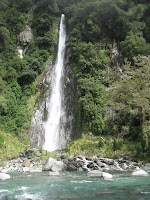
To get to Marlborough from the West Coast involved another crossing of the mountains that run along NZ's South island. This time the Lewis Pass, another challenge for our little 'chugger'. Glad to say that we made it without any problems (it is proving to be a sturdy little van - touch wood!) and ended up in Hanmer Springs. This is not only a ski resort (with one lift enough of a challenge for JP, but one wonders what other people see in it), but also, as the name would suggest, the happy owner of freshwater springs, and warm ones at that! Slowly getting used to the more relaxed lifstyle, we decided to spend the remainder of the day there, dipping in and out of pools with temperatures between 28C (the coldest) and 41C (the warmest - and the smelliest). With the sun out in its full glory, this turned out to be a most enjoyable day.
Relaxed and revitalised we set off to the Marlborough coast from there. As we had an early start and the weather was gorgeous, we chose the scenic route. And that's where our relaxedness ended - we expected that the scenic route involved kilometers and kilometers of twists and turns through seriously mountainous terrain and that there wouldn't be very many gas stations, but we hadn't expected our fuel economy to halve. So, going on empty we rolled into Kaikoura, our next stop, where we filled the 60 liter tank with 59 liters of gas. In 15 hours we went from feeling pampered in thermal mineral springs to feeling anxious about running out of gas. Still, we made it!
Kaikoura has a gorgeous setting - right at the sea with the mountains we had just crossed in the background. However, this is not the main reason people visit Kaikoura - whales are. This is the place on mainland NZ (and apparently in the rest of the world) where whales can be seen closest to shore. So, on board a fast catamaran we went for our go at whale spotting.

It has to be said, this was one of the most professionally run activities we've done so far this trip and it didn't disappoint - we saw two sperm whales (for those interested - we'll explain later) coming up for air and diving under again. However, what neither of us had taken seriously, the warnings for sea-sickness, turned out to be all too appropriate. First JP, later Nicola turned a grim colour green. Never have horizons and mountain peaks been studied so intensively, all to try to get to grips with the ongoing swell that caused us to feel like you do after a heavy night drinking. Fortunately it ended before one of us got properly sick, but the remainder of the day we felt as if we had taken a beating. In 20 hours from feeling pampered in thermal mineral springs to feeling beaten up. Still, we saw whales!
After a fish & chips, to line the stomach, we set out for a walk along the shore line to spot seals. Unfortunately the trail turned out to be different from the one indicated on the map, so it became of bit of exploring. With the tide coming in, our window was getting smaller but some good old-fashioned scouting helped us to find the way eventually. In 25 hours from feeling pampered in thermal mineral springs to feeling lost. Still, we saw seals!
After all this excitement, Blenheim was a more subdued event. Blenheim is Marlborough's capital of wine and as 40% of NZ's wine is grown in this area, this means something. Tens of winehouses have their home in Blenheim (and neighbouring Renwick) and we visited a selection. Given that we were still stocked up from our last wine trip (in Queenstown) we limited ourselves mainly to tasting. Which was equally (if not more) enjoyable. Added bonus for Nicola was the presence of a 'boutique' chocolate factory, basically every girl's dream. So it shouldn't come as a surprise that we ended up with some of this as well.


To show the diversity of Marlborough, our last day was spent in Picton (from where we'll take the ferry to the North Island). Picton is on the Marlborough Sounds, a 40 meter deep sunken river bed with access to open sea, full of sealife. By now we had seen albatrosses, fur seals and whales from up close, but dolphins (dusky dolphins to be precise) only through our binoculars. Picton offered the perfect opportunity to rectify this, as the Sounds are regularly visited by dolphins (including Orkas!), while they also house some unique birdlife.
On board another catamaran (glad to say not in open sea this time, so no greenness) we cruised the Sounds, indeed seeing dolphins surfing the bow of our boat (Hector dolphins, which are only found around NZ) less than one meter away. Mission accomplished! With the added bonus of some very special birds, including more albatrosses ('wandering' this time), saddlebacks (only 20 years ago only 39(!) were alive) and more shags (this time the 'little', the 'spotted' and, the very promisingly named 'king shag'). And as it was sunny, it became a nice afternoon on the water, allowing us to re-acquaint ourselves with this after our Kaikoura experience. A welcome re-acquaintance, given that tomorrow we will cross Cook's Strait in three hours to get to the North Island.
Which leaves us with reflecting back on our time here so far. Time has flown by, we've seen so many unique animals, we've done so many different things, we've been in so many different landscapes, it has been absolutely amazing. Let's see what the North Island has in store......
























